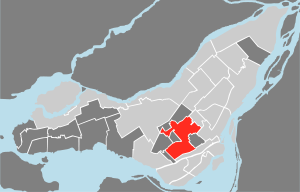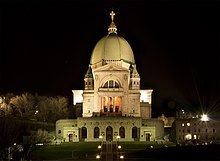Côte-des-Neiges-Notre-Dame-de-Grâce
| Côte-des-Neiges-Notre-Dame-de-Grâce | |
|---|---|

|
|
| city | Montreal |
| surface | 21.4 km² |
| Residents | 165,031 (2011) |
| native language |
French : 28.2% English : 28.4% Other: 43.4% |
| Community number | REM34 |
| Website | Arrondissement |
Côte-des-Neiges-Notre-Dame-de-Grâce is one of 19 arrondissements in the city of Montreal in the Canadian province of Quebec . In 2011 the 21.4 km² district had 165,031 inhabitants.
geography
Côte-des-Neiges-Notre-Dame-de-Grâce is located in the center of the Île de Montréal , west and southwest of Montreal's local mountain, Mont Royal . The very irregularly shaped district consists of two districts, Côte-des-Neiges in the north and Notre-Dame-de-Grâce in the south. Neighboring arrondissements of the city of Montreal are Outremont in the north, Ville-Marie in the east, Le Sud-Ouest in the southeast and Saint-Laurent in the west. In addition, it borders the following independent communities: Westmount in the east, Montréal-Ouest in the south, Côte-Saint-Luc in the southwest, Hampstead in the west and Mont-Royal in the northwest.
history
The place name Côte-des-Neiges refers to a small chapel that was built in memory of the snow miracle of Rome ( Maria Schnee ). Notre-Dame-de-Grâce commemorates the Marian veneration of the Mercedarian order and the monastery of the same name in the French town of Cotignac .
The settlement of Notre-Dame-de-Grâce began in 1650, that of Côte-des-Neiges in 1698. The Sulpizian order , who exercised the manorial rule over the island, parceled out the then densely forested area. As a result, farmers settled there who cleared the forest and planted fields. Over time, two villages developed, with numerous tanners also settling in Côte-des-Neiges . After the construction of new main roads, the villages grew into small suburbs in the second half of the 19th century, which attracted the Montreal bourgeoisie.
Notre-Dame-de-Grâce was a self-governing municipality from 1876, Côte-des-Neiges followed in 1889. After both municipalities had meanwhile received city rights, they were incorporated into Montreal in 1910. Due to the rapid expansion of the built-up areas, the once dominant agriculture gradually disappeared. A new development began in the 1930s when the French-speaking University of Montreal established its new campus. This was followed by the English-speaking Concordia University as well as several universities and hospitals. The St. Joseph's Oratory, completed in 1967, developed into an important sight .
population
According to the 2011 census, Côte-des-Neiges-Notre-Dame-de-Grâce had 165,031 inhabitants, which corresponds to a population density of 7712 inhabitants / km². It is thus the most populous district in Montreal. Of the respondents, 28.2% said French and 28.4% English were their mother tongue. Other important languages include Arabic (5.1%), Spanish (4.6%), Tagalog (4.4%), Chinese (3.9%), Russian (2.6%), Romanian (2, 5%) and Italian (1.7%).
Attractions
- St. Joseph's Oratory
- Notre-Dame-des-Neiges cemetery
- Center commémoratif de l'Holocauste in Montréal
- Center Segal des arts de la scene
- Concordia University's Loyola campus
- Université de Montréal
- École des hautes études commerciales
- École polytechnique de Montréal
Web links
- Website of the Arrondissement of Côte-des-Neiges-Notre-Dame-de-Grâce (French)
- History of Côte-des-Neiges
- History of Notre-Dame-de-Grâce
Individual evidence
- ↑ Annuaire statistique de l'agglomération de Montréal, recensement de 2011. (PDF, 728 kB) City Council of Montreal, Statistics Canada, 2011, accessed on February 25, 2014 (French, Statistical Yearbook of the Agglomeration of Montreal 2011).
Coordinates: 45 ° 29 ′ 27 ″ N , 73 ° 37 ′ 46 ″ W.

